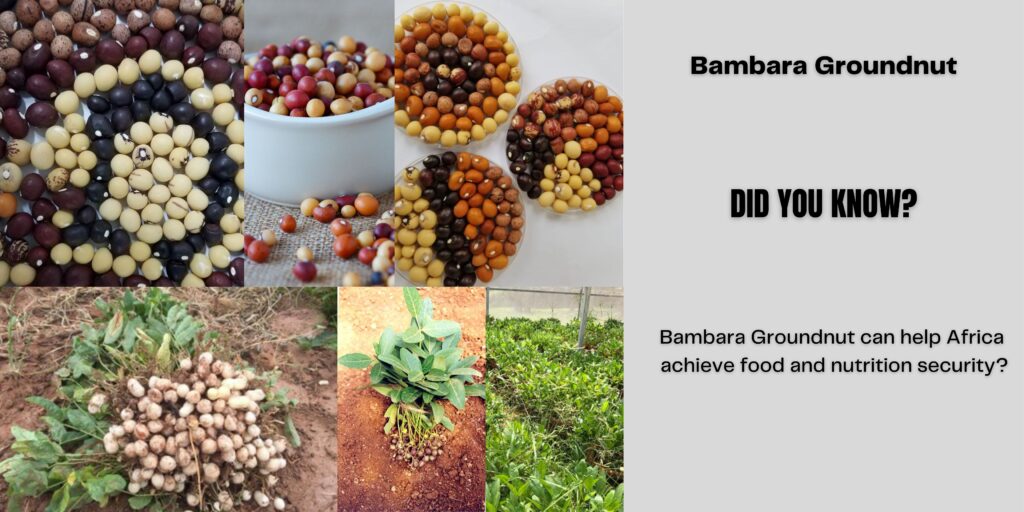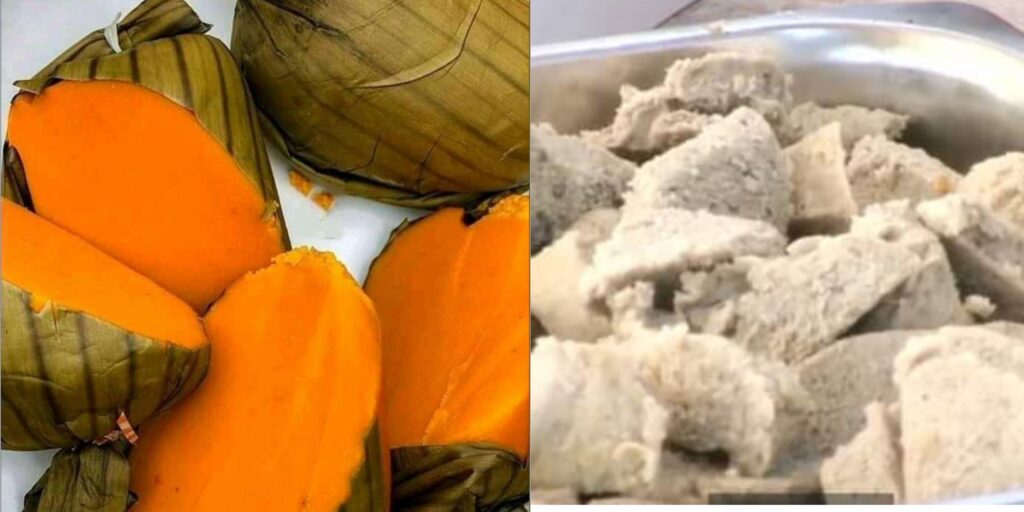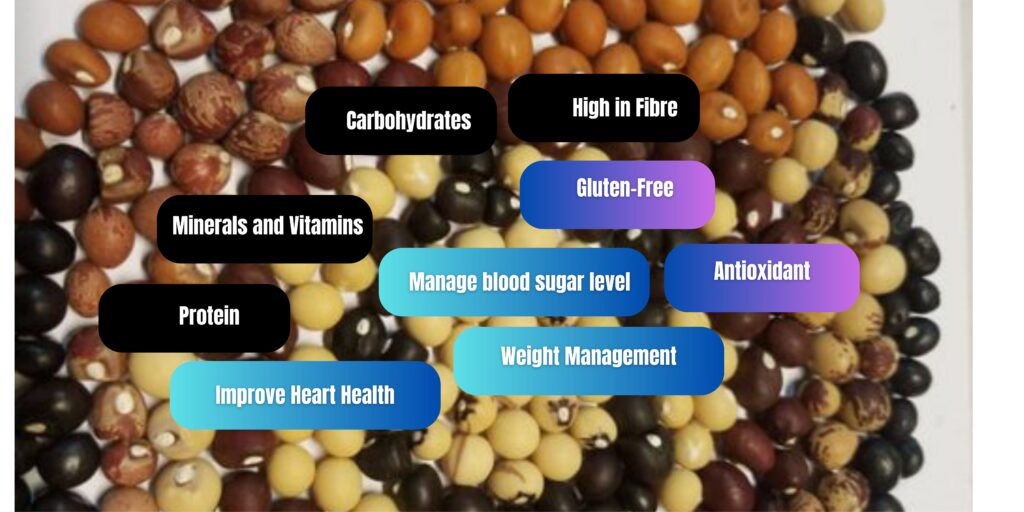Bambara Groundnut Health Benefits and Uses
In the face of a growing global population and increasing food demand, the Bambara groundnut emerges as a resilient and nutritious crop that can thrive in diverse African environments. Bambara groundnuts are a rich source of essential nutrients, and integrating them into diets can contribute to addressing malnutrition and hunger. Therefore, by promoting the cultivation and consumption of Bambara groundnuts, Africa can foster food and nutrition security and empower communities economically1.

Production of Bambara Groundnut
Bambara groundnut (Vigna subterranea), also known as Bambara bean, earth pea, or “simkpla” by Dagombas, is Africa’s third most cultivated leguminous crop. Nigeria is regarded as the largest producer of Bambara groundnut, followed by Burkina Faso and Niger2. However, despite the relevance of Bambara groundnuts in nutrition and health, they are relatively underutilized and associated with small-scale, subsistence farming, with women being the major producers and processors. Bambara groundnut is a climate-resilient crop due to its ability to adapt to various climates, fix nitrogen into the soil and low-input requirements. Its resilience is particularly valuable in climate change, where the unpredictability of weather patterns poses a significant threat to traditional crops3.
Uses of Bambara Groundnut
Simkpla:
Dagombas call Bambara groundnut Simkpla (round groundnut). So, boiled or cooked bambara groundnuts served with oil and onion are called simkpla or simkple dugura. This simple dish is very yummy and is one of the indigenous dishes my family enjoys a lot. You simply cannot get enough of it.
Yoroyoro:
In northern Ghana, especially among the Dagombas, Bambara beans are cooked with corn or maize, and the mixture is popularly called yoroyoro. It is served with spices, oil, and fried onions. Yoroyoro is a delicious dish with a unique taste.

Bambara groundnut fritters or bun or koose/kooshe:
Bambara groundnut fritters, buns, or koose/kooshe are popular snacks in West African cuisine, particularly in Ghana. These savoury fritters are made using Bambara groundnut flour, salt, onions, pepper, and eggs if desired. They are deep-fried until golden brown, resulting in a crispy exterior and a soft, flavourful interior. They are delicious with Hausa Koko or porridge.
Roasted Bambara bean Snacks:
Roasted Bambara groundnuts are a popular snack in some African countries. The nuts are roasted and seasoned with salt, spices, or herbs, creating a flavourful and crunchy snack. It is a snack I used to enjoy with my late dad at night while we chat.
Bambara Groundnut Stew:
Bambara groundnuts can be used as an ingredient in stews and sauces. The nuts are often added to tomato or vegetable stews to enhance flavour and provide a protein-rich element to the dish. It is very delicious when served with rice.
Tuubaani:
Tuubaani is a popular cuisine among the Dagombas from the Northern Region of Ghana. In Nigeria, it is called Okpa and is cooked with palm oil. It plays an important role in contributing to dietary protein and vitamin A intake among school children in Nigeria4. The Bambara groundnut flour is combined with water and sometimes other ingredients and then poured into rubber-like moulds or leaves. The mixture is steamed or boiled until it solidifies into a gel-like consistency. The rubber or leaves shape and cook the dish into a solid product with a unique texture and a nutty flavour. Tuubaani is enjoyed with hot spices, fried onions, and oil.

Bambara Groundnut Salad:
Fresh and cooked Bambara nuts can be added to salads, providing a protein boost and a nutty flavour.
These are just a few examples of the diverse ways Bambara groundnut is utilized in African cuisine. The preparation methods and dishes may vary across countries.
Nutrition and Health Benefits of Bambara Groundnut
Carbohydrates:
Carbohydrates are the most abundant nutrient in Bambara groundnut, accounting for up to 64.4 percent. Bambara beans provide the necessary energy for muscle and brain functions and the overall performance of the body.
Protein:
The protein content of Bambara groundnut has an average value of 23.6 percent. The composition of various protein elements makes Bambara groundnut a good complementary protein source to cereals5. Bambara groundnuts are a valuable component of a plant-based diet and are essential for the growth, repair, and maintenance of body tissues.
High in Fibre:
Bambara groundnut is rich in dietary fibre, which is beneficial for digestive health. Fibre helps promote regular bowel movements, prevents constipation, and supports a healthy digestive system.
Minerals and Vitamins:
Bambara groundnut contains minerals (potassium, magnesium, phosphorus, zinc, and iron), vitamins, and antioxidants6. These nutrients are important in various bodily functions, including energy metabolism, immune function, and antioxidant defence.

Manage blood sugar level:
Foods with a low glycemic index (GI) are associated with slower increases in blood sugar levels. Bambara groundnut has a relatively low glycemic index, which can be beneficial for individuals managing blood sugar levels.
Antioxidant:
The legume contains antioxidants that can help neutralize harmful free radicals in the body. Antioxidants play a role in protecting cells from oxidative stress and inflammation and may contribute to overall health.
Improve Heart Health:
The nutrients in Bambara groundnut may contribute to a healthy heart. Dietary fibre helps lower cholesterol levels, while potassium is important for maintaining healthy blood pressure. Also, fatty acids in Bambara groundnuts have positive effects on the heart, helping to reduce the levels of bad cholesterol. Lastly, the antioxidants combat stress and inflammation and, therefore, protect the cardiovascular system.
Gluten-Free:
Bambara groundnut is naturally gluten-free, making it a suitable option for individuals with gluten sensitivities or celiac disease.
Weight Management:
Bambara groundnut is also good for weight management. The combination of protein and fibre in Bambara groundnut can contribute to a feeling of fullness and satiety, which may help with weight management by reducing overall calorie intake.
Bambara groundnut, therefore, is an essential legume, and its inclusion in diets is necessary to foster food and nutrition security in Africa.
By: *Ayisha Gunu Mohammed (Agricultural Biotechnology Graduate and Researcher) and Huzeima Mahamadu (Researcher and Storyteller)
References
- Mbosso, C., Boulay, B., Padulosi, S., Meldrum, G., Mohamadou, Y., Berthe Niang, A., Coulibaly, H., Koreissi, Y., & Sidibé, A. (2020). Fonio and Bambara Groundnut Value Chains in Mali: Issues, Needs, and Opportunities for Their Sustainable Promotion. Sustainability, 12(11), 4766. https://doi.org/10.3390/su12114766 ↩︎
- Hillocks, R., Bennett, C., & Mponda, O. (2012). Bambara nut: A review of utilisation, market potential and crop improvement. African Crop Science Journal, 20(1). ↩︎
- Oyeyinka, S. A., & Oyeyinka, A. T. (2018). A review on isolation, composition, physicochemical properties and modification of Bambara groundnut starch. Food Hydrocolloids, 75, 62–71. https://doi.org/10.1016/j.foodhyd.2017.09.012 ↩︎
- Boye, J., Zare, F., & Pletch, A. (2010). Pulse proteins: Processing, characterization, functional properties and applications in food and feed. Food Research International, 43(2), 414–431. https://doi.org/10.1016/j.foodres.2009.09.003 ↩︎
- Boye, J., Zare, F., & Pletch, A. (2010). Pulse proteins: Processing, characterization, functional properties and applications in food and feed. Food Research International, 43(2), 414–431. https://doi.org/10.1016/j.foodres.2009.09.003 ↩︎
- Qaku, X. W., Adetunji, A., & Dlamini, B. C. (2020). Fermentability and nutritional characteristics of sorghum Mahewusupplemented with Bambara groundnut. Journal of Food Science, 85(6), 1661–1667. https://doi.org/10.1111/1750-3841.15154 ↩︎
